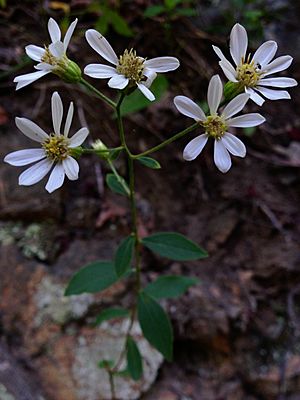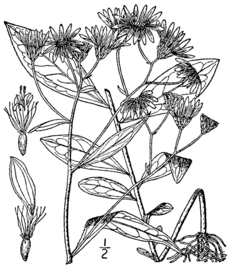Cornel-leaf whitetop facts for kids
Quick facts for kids Cornel-leaf whitetop |
|
|---|---|
 |
|
| Scientific classification | |
| Genus: |
Doellingeria
|
| Species: |
infirma
|
| Synonyms | |
The Cornel-Leaf Whitetop (scientific name: Doellingeria infirma) is a beautiful wild plant. It is also called the cornel-leaved aster. This plant grows back year after year, which means it is a perennial plant. It is a type of forb, which is a plant that is not woody, like a tree or shrub. The Cornel-Leaf Whitetop is native to the eastern parts of the United States. In late summer, it grows lovely white flowers that look like a single bloom but are actually made of many tiny flowers grouped together.
What Does the Cornel-Leaf Whitetop Look Like?
The Cornel-Leaf Whitetop has a smooth, thin stem. This stem usually grows to be about 45 to 90 centimeters (18 to 36 inches) tall. Near the top, the stem can be a bit rough and has a few branches.
This plant does not have leaves at its base, near the ground. The leaves lower down on the stem are small and shaped like an egg, wider at the top. As you look higher up the stem, the leaves get bigger. They are usually 5 to 12 centimeters (2 to 5 inches) long and 2.5 to 4 centimeters (1 to 3 inches) wide. These larger leaves are shaped like a long oval with pointed ends. Their edges are smooth, without any teeth or lobes. The top side of the leaves is smooth, while the underside has a few stiff hairs along the veins.
The plant usually has between 3 and 33 flower heads. Each flower head is actually a cluster of many small flowers. These clusters are made up of 4 to 20 "disc florets" (the tiny flowers in the center) and 3 to 11 "ray florets" (the petal-like flowers around the edge). All these flower heads grow together in a flat-topped cluster at the very top of the stem.
After the flowers bloom, the plant produces small fruits. These fruits are called cypselae. Each fruit has a fluffy top, like a tiny parachute, made of tawny (a brownish-orange color) bristles. This fluffy top helps the seeds float away in the wind.
Where Does This Plant Grow?
The Cornel-Leaf Whitetop grows in many places across the eastern United States. You can find it from Alabama and the Florida Panhandle in the south, all the way north to Massachusetts, Ohio, and New York State.
Even though it's found in many states, it might not grow everywhere in those states. Its presence depends on having the right kind of habitat. For example, in Virginia, it likes to grow in woodlands that are not too wet and not too dry. It also grows in clearings, which are open areas in forests.
This plant needs a specific environment to thrive. If its habitat changes, for example, due to new buildings or different ways people use the land, the plant might disappear from that area. Also, if other plants that are not native to the area (called invasive species) start growing there, they can take over and push out the Cornel-Leaf Whitetop.
Is This Plant in Danger?
In some parts of the United States, the Cornel-Leaf Whitetop is becoming rare. Because of this, it has a special "conservation status" in certain states.
- In Massachusetts, it is listed as an "endangered" species. This means it is at a very high risk of disappearing from the state.
- In Rhode Island, it is listed as "historical." This means it used to grow there, but it hasn't been seen in a long time and might no longer exist in the wild in that state.
- In Connecticut, it is considered a "species of special concern." This means scientists are worried about it. It is also "believed extirpated," which means it is thought to have completely disappeared from the wild in Connecticut.
These statuses show that it's important to protect the places where the Cornel-Leaf Whitetop grows so that future generations can still see this unique plant.


